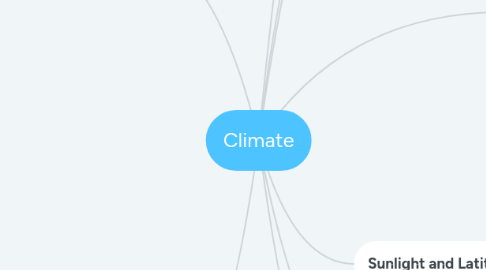
1. Greenhouse effect
1.1. HEAT TRANSFER MECHANISM: Radiation is the transfer of energy through space by electromagnetic radiation. Conduction is the transfer of heat energy from one substance to another from the collisions of particles. Convection is the transfer of energy in fluids (liquid or gas) by formation of currents
1.1.1. HEAT ON EARTH: Radiation and convection will be the most important for the climate. Energy on Earth arrives from the Sun through radiation.
1.1.1.1. RADIATION FROM THE SUN: - Radiation from the Sun is mostly in the form of visible light (visible light spectrum). - The Earth surface absorbs the high-energy radiation and re-emits lower energy radiation as heat. - Most of the radiation from the Sun passes through the atmosphere. Some is reflected back by the atmosphere and clouds. - Earth’s surface absorbs high-energy radiation and re-emits them as low-energy radiation (heat). Earth’s emitted radiation is infra-red, not visible/UV - Solar radiation has little interactions with the atmosphere. Infrared radiation emitted by Earth does interact with certain molecules. - Up to 85% of the re-emitted heat is absorbed by greenhouse gases in the atmosphere.
1.1.1.1.1. What if Earth does not have an atmosphere? The Moon is roughly the same distance from the Sun as Earth but does not have an atmosphere. Temperature on the Moon fluctuates tremendously between day and night (super hot in the day and super cold at night). Life on Earth would not be possible without the atmosphere and the greenhouse effect.
1.2. GREENHOUSE EFFECTS: The re-absorption of infrared radiation by the atmosphere. It traps energy like a greenhouse. The main greenhouse gases are: carbon dioxide (CO2), water (H20), Methane (CH4), Nitrous Oxide (N20),... PPM (Parts Per Million) (Units of quantity): It means in one million particles, how many particles are those gases we counted for. Example: 400 ppm means 400 particles out of 1,000,000 particles
1.3. Heat (thermal energy) is the driving force of the climate and heat is absorbed and distributed around the planet. It always moves from an area of high temperature to low temperature.
2. Greenhouse gasses
2.1. Carbon Dioxide (CO2): This gas is responsible for ~25% of the greenhouse effects. Can be “made” from: respiration, burning organic matter, industry, coal/fossil fuel,... 412 ppm (current level); 280 ppm (pre-industry)
2.1.1. Water Vapour (H2O): Ranges from 0%-4% in the atmosphere Responsible for ~65% of the greenhouse effects
2.1.1.1. Methane (CH4): 1.785 ppm (current); 0.7 ppm (pre-industry) As a greenhouse gas, it is 21 times more effective in absorbing radiation than CO2.
2.1.1.1.1. Nitrous Oxide (N2O): 0.321 ppm (current); 0.27 (pre-industry) As a greenhouse gas, it is 206 times more effective than CO2. It is created from natural reactions of plants with the soil, from car exhaust, industry,...
3. Insolation
3.1. Sunlight also enters land, oceans and the atmosphere as heat.
3.2. Sunlight absorbed by plants is used for photosynthesis.
4. Water
4.1. Water regulates temperature
4.2. Water carries energy in the ocean and atmosphere.
5. Proximity to Water
5.1. Regions near large bodies of water have:
5.1.1. More moderate temperature
5.1.1.1. More precipitation
6. Sunlight and Latittude
6.1. Sunlight rays are more spread out near the pole, resulting in a cooler climate. It is more concentrated near the equator, resulting in a warmer climate.
6.2. Water stores energy as heat
6.3. Effects of Latitude: Regions within the tropics are warmer than those outside.
6.3.1. Latitude has an impact on how much sunlight is received in the area.
7. Geography (Elevation)
7.1. The higher the elevation, the less air and water there are.
7.1.1. The temperature is also lower and it’s also dryer the higher the elevation.
7.1.1.1. This can influence the growth of vegetation.
7.2. As air rises (increase in elevation), it begins to cool
7.2.1. It lowers temperatures
7.2.1.1. Water precipitates (falls out, condense)
8. Mountains
8.1. This forms a rain shadow where it is drier on the other side of the mountain.
8.2. Moist air blowing from the sea is blocked by mountains, condensing them into clouds and rains.
9. Biomes
9.1. Climate regions can be splitted up into biomes (collections of ecosystems that share similar climatic conditions).
9.1.1. 5 CLASSES OF BIOMES: Forest Desert Tundra Grassland Aquatic
9.1.1.1. CLIMATE FACTORS & PLANT GROWTHS: Sunlight: crucial “ingredients” in the process of photosynthesis Water: crucial for sustaining plants’ life and for the process of photosynthesis. Temperature: affects the rate of photosynthesis
